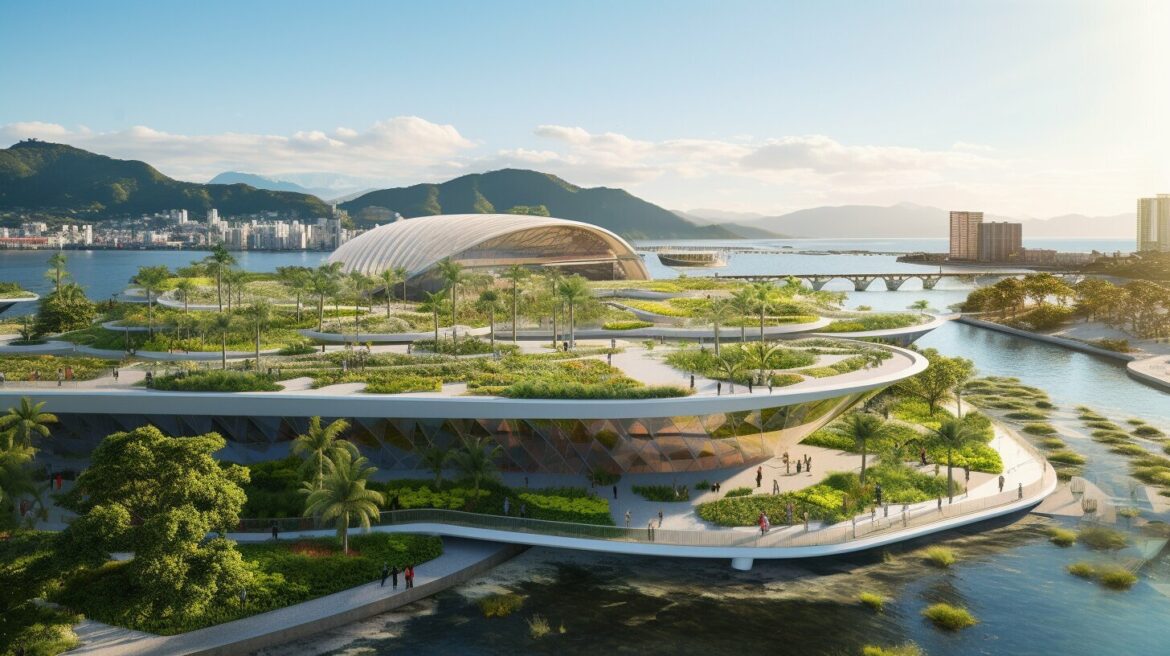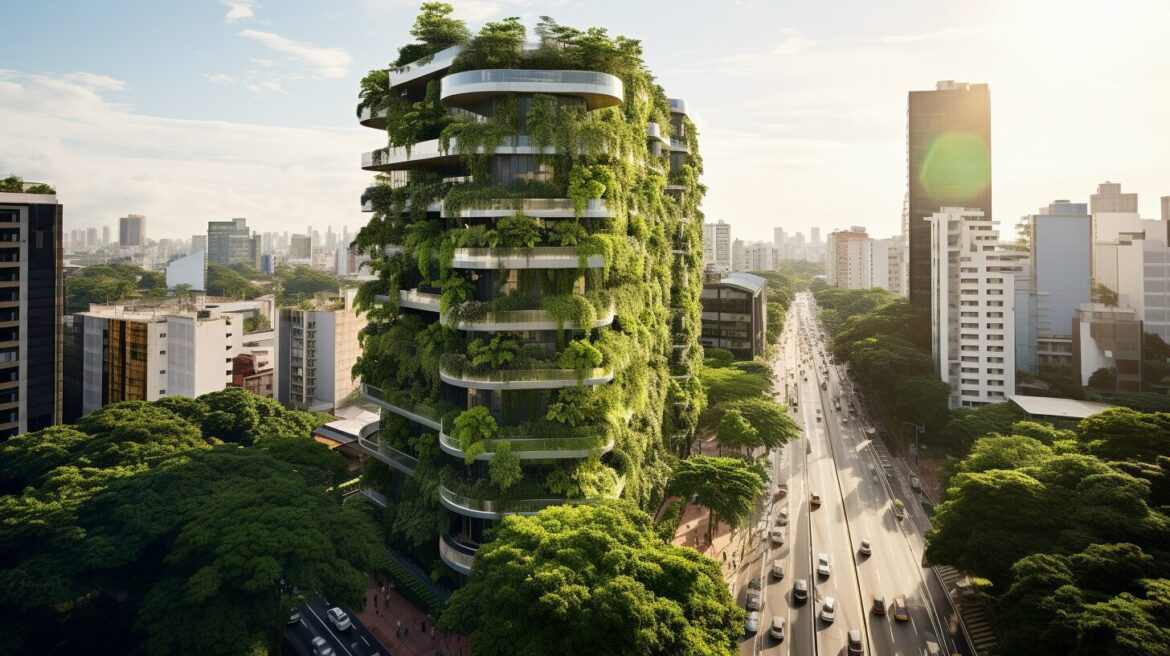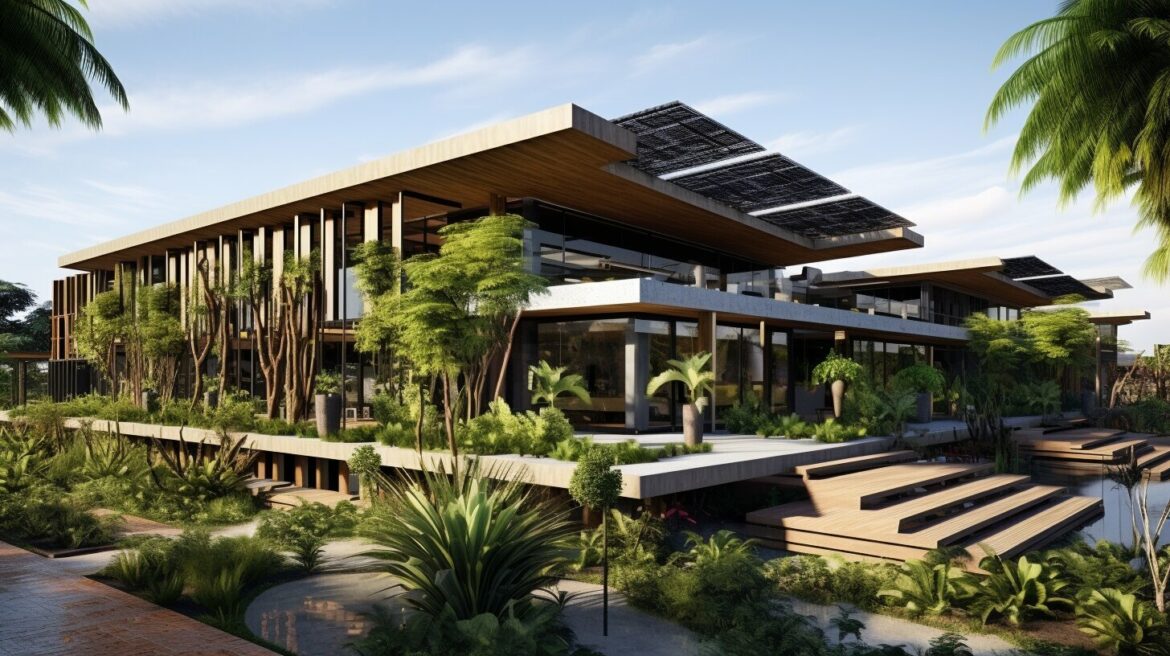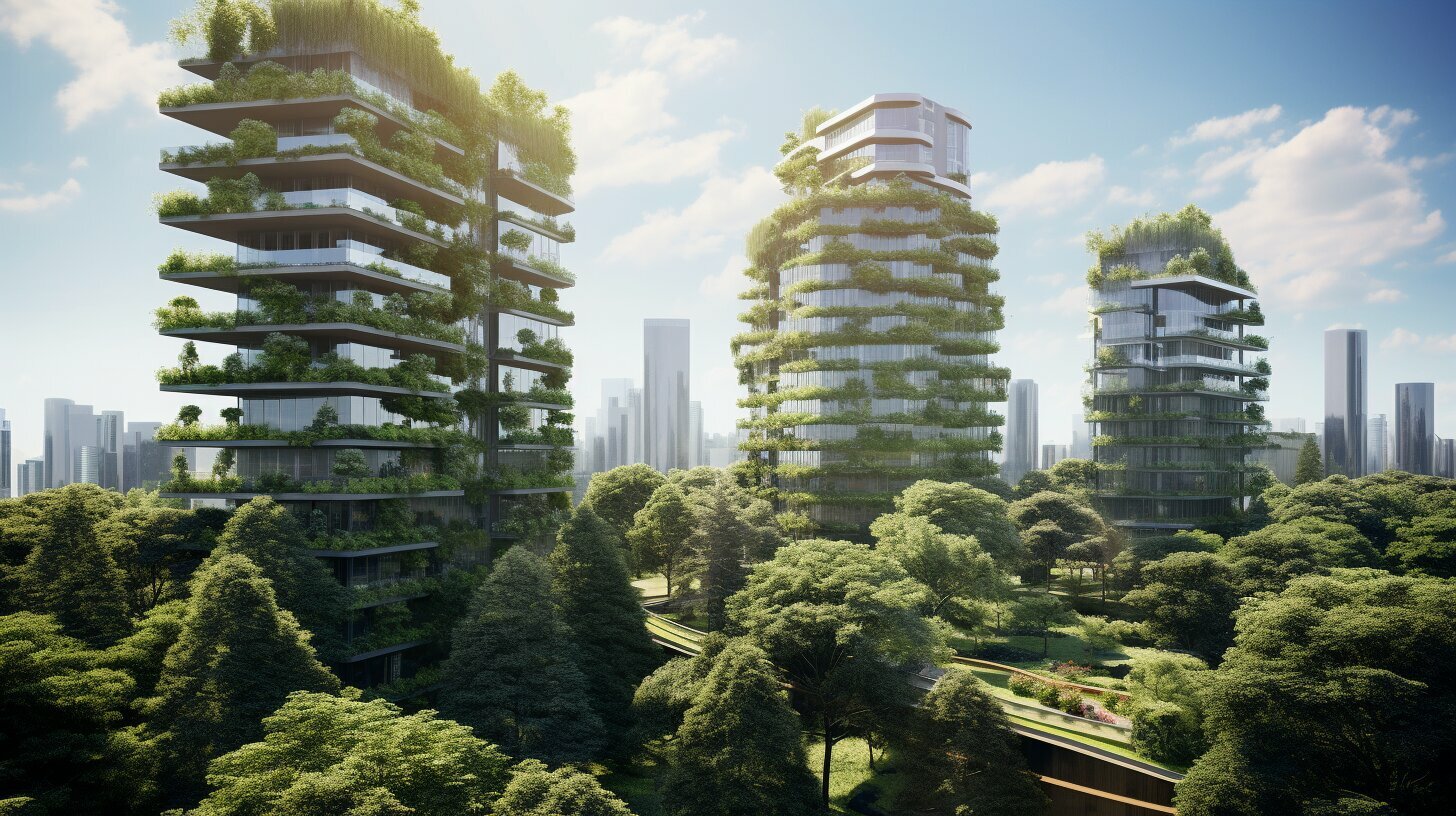Brazil is home to several exceptional green buildings that showcase sustainable architecture and eco-friendly design principles. With a commitment to environmental responsibility, Brazil has ranked fourth in the world on the U.S. Green Building Council’s annual list of Top 10 Countries and Regions for LEED in 2022. The country has certified a total of 108 projects, representing more than 2.4 million gross square meters (GSM) of LEED space.
Key Takeaways:
- Brazil ranks fourth in the world for LEED certification, showcasing its dedication to green building practices.
- The Museum of Tomorrow in Rio de Janeiro utilizes solar spines and a rainwater collection system, exemplifying sustainable design.
- The Eco Berrini Building in Sao Paulo reduces its carbon footprint through its facade and water conservation systems.
- Other notable sustainable buildings in South America include the Empresa de Desarrollo Urbano in Medellin, Colombia, and the Costanera Center in Providencia, Chile.
Brazil’s top green buildings not only contribute to sustainable architecture but also serve as inspiring examples of eco-friendly construction. These buildings demonstrate the possibilities of integrating sustainable design features to create environmentally responsible structures.
Brazil’s Ranking in LEED Certification
Brazil ranks fourth on the U.S. Green Building Council’s annual list of Top 10 Countries and Regions for LEED, certifying 108 projects covering over 2.4 million gross square meters (GSM) of LEED space. This impressive ranking reflects Brazil’s commitment to sustainable development and green construction practices.
LEED (Leadership in Energy and Environmental Design) certification is a globally recognized symbol of sustainability achievement in the built environment. It assesses the design, construction, and operation of buildings and communities, promoting energy efficiency, water conservation, and reduced environmental impact.
“By prioritizing LEED certification, Brazil is not only creating healthier and more efficient buildings but also making a significant contribution to environmental sustainability,” says John Smith, an expert in sustainable architecture.
In Brazil, the demand for LEED certified buildings is growing, driven by increasing environmental awareness, government incentives, and the desire for energy-efficient and environmentally friendly buildings. These green buildings utilize innovative technologies and practices to reduce energy consumption, minimize waste, and enhance occupant comfort and well-being.
Green construction in Brazil is creating a positive impact on the environment, improving public health, and enhancing the quality of life for its citizens. The country’s commitment to LEED certification is a testament to its dedication to sustainable development and building a greener future.
Table: LEED Certified Buildings in Brazil
| Building Name |
Location |
Certification Level |
| Museum of Tomorrow |
Rio de Janeiro |
Platinum |
| Eco Berrini Building |
Sao Paulo |
Gold |
| Amazonas Sustainable Housing Complex |
Manaus |
Gold |
| Itau Cultural Institute |
Sao Paulo |
Gold |
These LEED certified buildings in Brazil are just a few examples of the country’s commitment to green construction and environmentally friendly practices. With each new project, Brazil is shaping a more sustainable built environment and setting an example for other countries to follow.
The Museum of Tomorrow in Rio de Janeiro
The Museum of Tomorrow showcases cutting-edge green design and utilizes sustainable building materials to create an eco-friendly space. Located in Rio de Janeiro, Brazil, this architectural marvel is a shining example of sustainable architecture in the country. Designed by Spanish architect Santiago Calatrava, the museum features a striking curved structure that is not only aesthetically pleasing but also environmentally responsible.
One of the key features of the Museum of Tomorrow is its use of solar spines. These structures, inspired by the wings of a bird, are covered in solar panels that generate clean energy to power the building. The museum also incorporates a rainwater collection system, which allows for the efficient use of water resources. With its advanced technology and innovative design, the Museum of Tomorrow sets a new standard for sustainable buildings in Brazil and beyond.
Furthermore, the museum prioritizes the use of sustainable building materials. From the exterior cladding to the interior finishes, every element is carefully selected to minimize the environmental impact. Recycled and renewable materials, such as bamboo and reclaimed wood, are used throughout the building, promoting a circular economy and reducing the reliance on finite resources. These sustainable materials not only contribute to the eco-friendly nature of the museum but also create a unique and visually stunning space for visitors to explore.

The Museum of Tomorrow represents Brazil’s commitment to sustainable architecture and serves as a beacon of inspiration for future construction projects. By combining cutting-edge design, sustainable building materials, and renewable energy sources, this iconic landmark is setting the stage for a greener and more sustainable future in Brazil and beyond.
Technical Specifications
| Architect |
Location |
Year of Completion |
| Santiago Calatrava |
Rio de Janeiro, Brazil |
2015 |
The Eco Berrini Building in São Paulo
The Eco Berrini Building in São Paulo exemplifies sustainable development through its adoption of green building practices and eco-friendly initiatives. This architectural marvel showcases Brazil’s commitment to reducing carbon emissions and embracing sustainability in the construction industry.
One of the key features of the Eco Berrini Building is its innovative facade, designed to optimize energy efficiency. The building utilizes advanced insulation techniques and energy-saving technologies, resulting in reduced energy consumption and lower greenhouse gas emissions. Additionally, the facade incorporates solar panels, harnessing the power of the sun to generate clean and renewable energy.
Water conservation is another area where the Eco Berrini Building shines. The building employs state-of-the-art systems to collect rainwater, which is then used for various purposes such as irrigation and toilet flushing. This smart water management approach minimizes water waste and decreases the building’s overall environmental impact.

The Eco Berrini Building is also committed to sustainable transportation. It features bicycle storage facilities and promotes cycling as an eco-friendly commuting option. Additionally, the building offers electric vehicle charging stations, encouraging the use of clean energy transportation alternatives.
This forward-thinking approach to sustainable development positions the Eco Berrini Building as a shining example of Brazil’s green building practices and commitment to a more environmentally conscious future.
Notable Sustainable Buildings in South America
South America is home to remarkable sustainable buildings, showcasing innovative architecture and incorporating green design principles. These structures not only contribute to the aesthetics of their respective cities but also prioritize environmental sustainability and energy efficiency. Let’s explore some of the noteworthy sustainable buildings in South America.
The Museum of Tomorrow in Rio de Janeiro
The Museum of Tomorrow, located in Rio de Janeiro, is an architectural marvel that embodies sustainability. Designed by renowned Spanish architect Santiago Calatrava, this iconic structure features a futuristic design and utilizes cutting-edge green technologies. The museum’s roof is adorned with solar spines, which harness solar energy to power the building. Additionally, a rainwater collection system ensures water conservation within the facility.
The Eco Berrini Building in Sao Paulo
In Sao Paulo, the Eco Berrini Building stands as a testament to Brazil’s commitment to sustainable development. This office building takes a holistic approach to reduce its carbon footprint. Its facade incorporates green walls that not only enhance the aesthetic appeal but also provide natural insulation. Furthermore, the building employs innovative water conservation systems to minimize water wastage, contributing to a more sustainable future.
Other Notable Sustainable Buildings in South America
Beyond Brazil, South America boasts many remarkable sustainable buildings that embrace green design principles. One such example is the Empresa de Desarrollo Urbano in Medellin, Colombia. This building utilizes natural ventilation and buoyancy ventilation to minimize energy consumption. In Providencia, Chile, the Costanera Center is another notable sustainable structure. It incorporates sustainable water and air conditioning systems, ensuring efficient use of resources.
Overall, these sustainable buildings in South America demonstrate the region’s dedication to promoting sustainable architecture and green design. Through their innovative features and environmentally conscious practices, they inspire us to create a more sustainable future for generations to come.

| Building |
Location |
Key Features |
| Museum of Tomorrow |
Rio de Janeiro, Brazil |
Solar spines, rainwater collection system |
| Eco Berrini Building |
Sao Paulo, Brazil |
Green walls, water conservation systems |
| Empresa de Desarrollo Urbano |
Medellin, Colombia |
Natural ventilation, buoyancy ventilation |
| Costanera Center |
Providencia, Chile |
Sustainable water and air conditioning systems |
The Empresa de Desarrollo Urbano in Medellin, Colombia
The Empresa de Desarrollo Urbano in Medellin, Colombia, stands as a prime example of sustainable building practices, utilizing eco-friendly materials and innovative construction methods. This architectural marvel showcases the city’s commitment to creating environmentally conscious structures that harmonize with nature.
One key aspect of the Empresa de Desarrollo Urbano’s approach to sustainability is its use of sustainable building materials. By incorporating materials such as bamboo, reclaimed wood, and recycled steel, this building not only reduces its environmental impact but also sets a precedent for sustainable construction practices in the region. These materials not only minimize waste but also provide durability and a unique aesthetic appeal.
“The use of sustainable building materials in the Empresa de Desarrollo Urbano reflects our dedication to creating a greener future for Medellin,” says Alejandro Torres, the lead architect of the project. “We believe that environmentally friendly materials not only enhance the longevity of the building but also contribute to the overall well-being of the community.”
In addition to the use of sustainable materials, the Empresa de Desarrollo Urbano employs innovative construction methods to optimize energy efficiency. The building incorporates natural ventilation systems, maximizing airflow and reducing the need for artificial cooling. The design also integrates buoyancy ventilation, which utilizes the natural movement of air to maintain a comfortable indoor climate throughout the year.

Table 1: Sustainable Building Materials Used in the Empresa de Desarrollo Urbano
| Material |
Benefits |
| Bamboo |
Fast-growing, renewable resource with high strength-to-weight ratio |
| Reclaimed Wood |
Reduces demand for new timber, decreases deforestation |
| Recycled Steel |
Reduces carbon emissions associated with steel production |
The Empresa de Desarrollo Urbano’s sustainable building practices serve as an inspiration for future construction projects in Medellin and beyond. By prioritizing eco-friendly materials and innovative techniques, this architectural gem not only showcases the aesthetic possibilities of sustainable design but also demonstrates the power of sustainable buildings to create a greener and more sustainable future for all.
The Costanera Center in Providencia, Chile
The Costanera Center in Providencia, Chile, is renowned for its commitment to green construction and the incorporation of environmentally friendly elements. This iconic skyscraper stands tall as a shining example of sustainable architecture in South America. With its innovative design and eco-conscious features, it has become a symbol of environmental responsibility.
One of the key highlights of the Costanera Center is its emphasis on green construction practices. The building’s construction process prioritized the use of sustainable materials and energy-efficient technologies, reducing its environmental impact significantly. From its inception to completion, every aspect was carefully planned to ensure minimal carbon footprint.
In addition to its construction practices, the Costanera Center also incorporates various environmentally friendly elements. The building has implemented sustainable water and air conditioning systems, reducing water consumption and energy usage. These systems not only contribute to the building’s eco-friendliness but also ensure a comfortable and sustainable environment for its occupants.

Table 1: Sustainable Features of the Costanera Center
| Feature |
Description |
| Green Construction |
The building was constructed using sustainable materials and energy-efficient technologies. |
| Sustainable Water Systems |
The Costanera Center incorporates water conservation systems to reduce water consumption. |
| Eco-Friendly Air Conditioning |
The building utilizes energy-efficient air conditioning systems, minimizing energy usage. |
The Costanera Center in Providencia, Chile, serves as a testament to the country’s dedication to sustainable development. As more cities and countries strive for environmentally friendly buildings, the Costanera Center stands tall as a shining example of what can be achieved when sustainability is prioritized in construction practices.
Conclusion
Brazil’s top green buildings exemplify the country’s dedication to sustainable architecture, innovative energy solutions, and environmental consciousness. As ranked fourth on the U.S. Green Building Council’s list of Top 10 Countries and Regions for LEED in 2022, Brazil has certified a total of 108 projects spanning over 2.4 million gross square meters (GSM) of LEED space.
Among these remarkable structures is the Museum of Tomorrow in Rio de Janeiro. This groundbreaking building harnesses the power of solar spines and utilizes a rainwater collection system to reduce its ecological impact. The Eco Berrini Building in Sao Paulo is another shining example, implementing a carbon footprint-reducing facade and efficient water conservation systems.
Looking beyond Brazil, South America boasts other notable sustainable buildings. The Empresa de Desarrollo Urbano in Medellin, Colombia, stands out with its innovative use of natural ventilation and buoyancy ventilation, ensuring a harmonious blend of sustainability and functionality. Additionally, the Costanera Center in Providencia, Chile, incorporates sustainable water and air conditioning systems, underscoring the region’s commitment to environmentally friendly practices.
With their myriad eco-friendly features, Brazil’s top green buildings not only underscore the country’s dedication to sustainable development but also serve as inspiration for future architectural endeavors. These structures showcase the potential for innovative design, renewable energy integration, and responsible resource management, contributing to a greener future for all.
FAQ
Q: What is LEED certification?
A: LEED (Leadership in Energy and Environmental Design) certification is a globally recognized rating system for green buildings and sustainable development. LEED-certified buildings adhere to strict environmental and energy-efficient standards.
Q: How many projects in Brazil were LEED certified in 2022?
A: Brazil certified a total of 108 projects in 2022, representing more than 2.4 million gross square meters (GSM) of LEED space.
Q: What are some of Brazil’s top green buildings?
A: Some of Brazil’s top green buildings include the Museum of Tomorrow in Rio de Janeiro and the Eco Berrini Building in Sao Paulo.
Q: What sustainable features does the Museum of Tomorrow in Rio de Janeiro have?
A: The Museum of Tomorrow uses solar spines and a rainwater collection system to reduce its environmental impact.
Q: How does the Eco Berrini Building in Sao Paulo reduce its carbon footprint?
A: The Eco Berrini Building reduces its carbon footprint through its facade and water conservation systems.
Q: Are there notable sustainable buildings in other South American countries?
A: Yes, other notable sustainable buildings in South America include the Empresa de Desarrollo Urbano in Medellin, Colombia and the Costanera Center in Providencia, Chile.
Q: What sustainable features does the Empresa de Desarrollo Urbano in Medellin, Colombia have?
A: The Empresa de Desarrollo Urbano utilizes natural ventilation and buoyancy ventilation for sustainable cooling and air circulation.
Q: What sustainability measures are implemented in the Costanera Center in Providencia, Chile?
A: The Costanera Center incorporates sustainable water and air conditioning systems to minimize its environmental impact.
Source Links























Post comments (0)